Leading and Managing People Report
VerifiedAdded on 2019/10/31
|7
|1170
|201
Report
AI Summary
This report examines the leadership theories and styles of three influential leaders: Jack Welch (General Electric), Ursula Burns (Xerox), and Barack Obama (President of the United States). It analyzes how their approaches, including transformational, motivational, and multicultural leadership, contributed to their success. The report details Welch's focus on motivation, vision, and emotional intelligence; Burns' emphasis on openness, direct communication, and employee empowerment; and Obama's use of charisma, cross-cultural understanding, and contingency-situational leadership. The conclusion highlights the applicability of these leadership theories to various contexts and the importance of adapting strategies to specific situations. The report concludes that while some risks are inherent in bold leadership decisions, these leaders successfully transformed their organizations and impacted the world through their unique approaches.

Running head: LEADING AND MANAGING PEOPLE
LEADING AND MANAGING PEOPLE
Name of Student
Name of University
Author Name
LEADING AND MANAGING PEOPLE
Name of Student
Name of University
Author Name
Paraphrase This Document
Need a fresh take? Get an instant paraphrase of this document with our AI Paraphraser
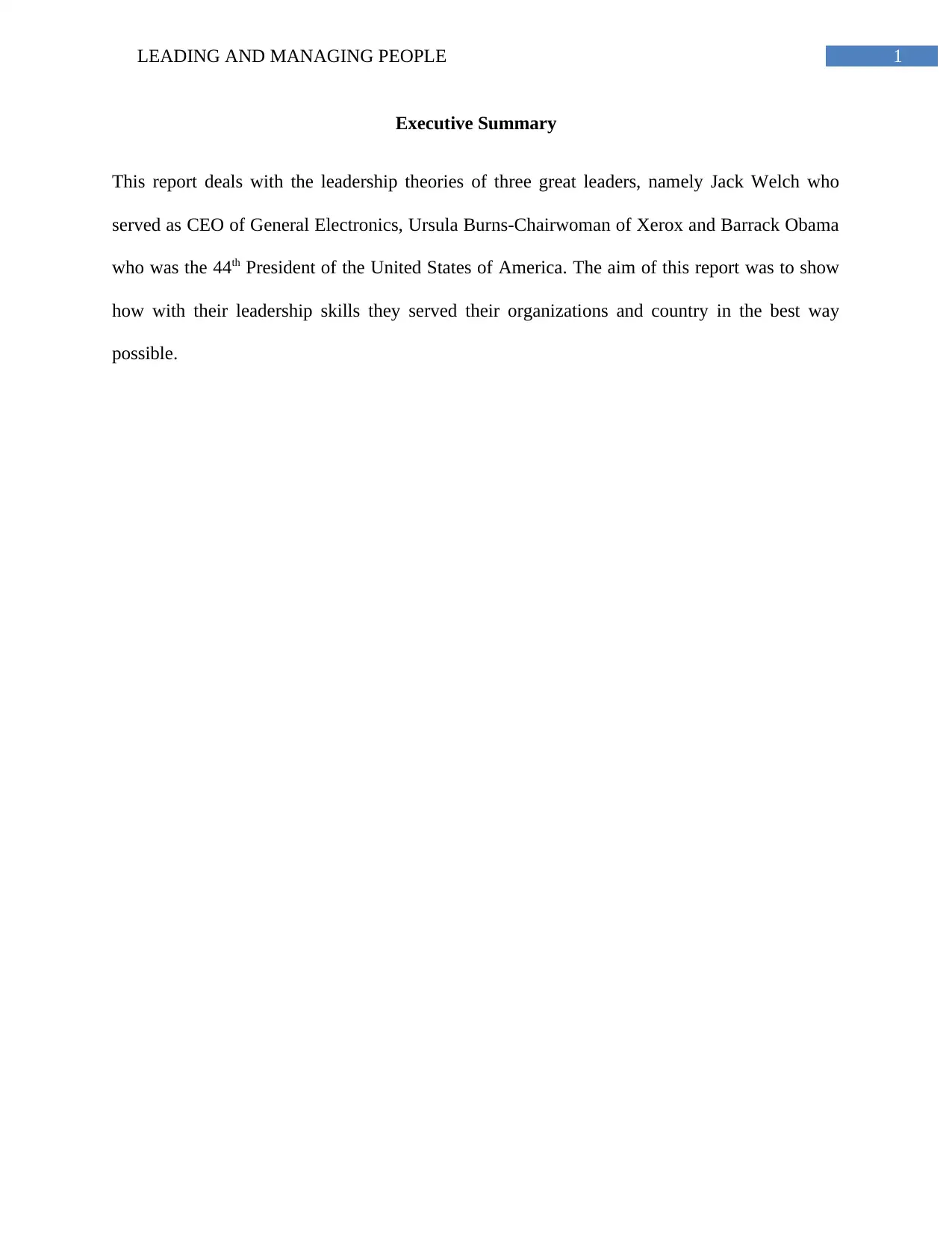
1LEADING AND MANAGING PEOPLE
Executive Summary
This report deals with the leadership theories of three great leaders, namely Jack Welch who
served as CEO of General Electronics, Ursula Burns-Chairwoman of Xerox and Barrack Obama
who was the 44th President of the United States of America. The aim of this report was to show
how with their leadership skills they served their organizations and country in the best way
possible.
Executive Summary
This report deals with the leadership theories of three great leaders, namely Jack Welch who
served as CEO of General Electronics, Ursula Burns-Chairwoman of Xerox and Barrack Obama
who was the 44th President of the United States of America. The aim of this report was to show
how with their leadership skills they served their organizations and country in the best way
possible.
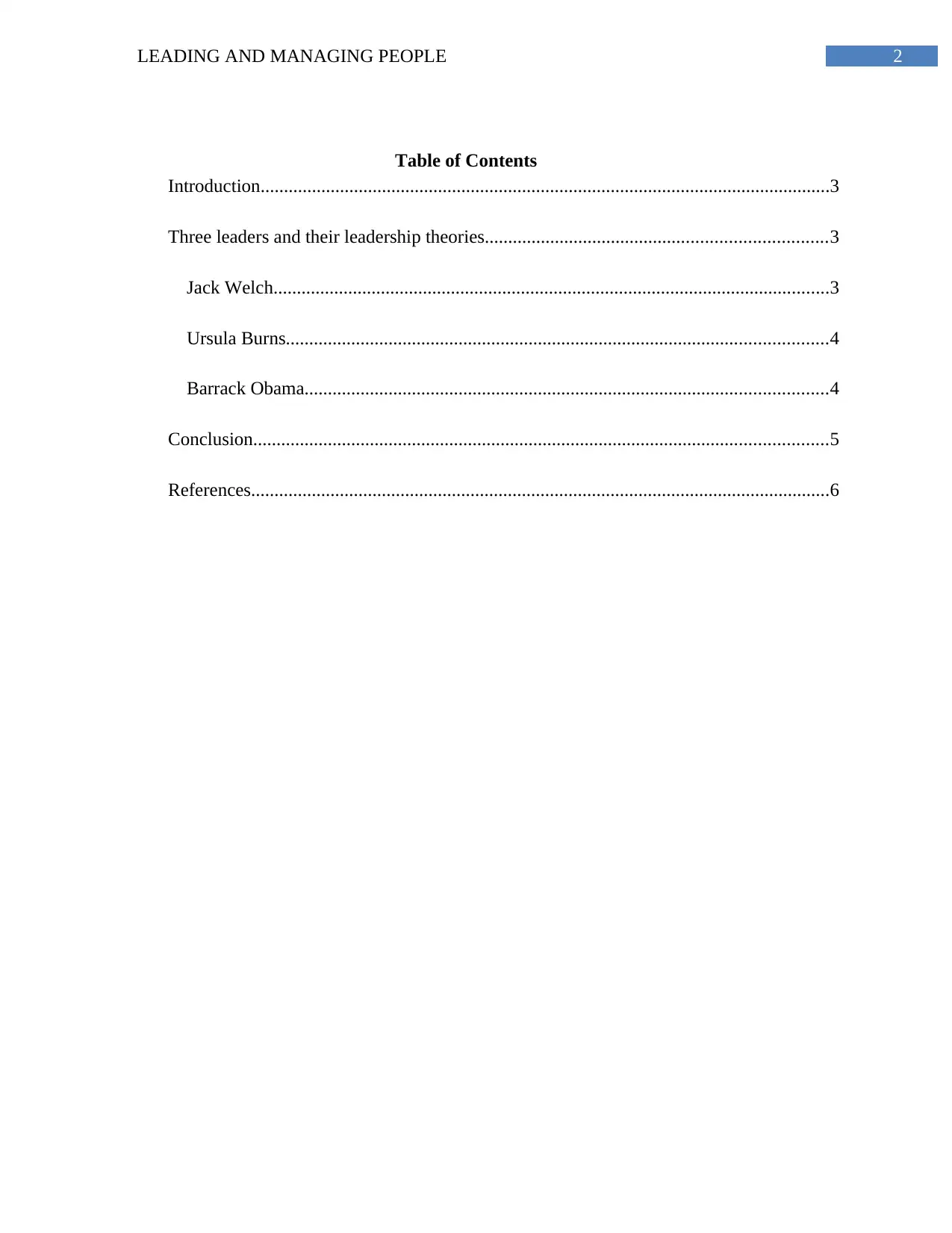
2LEADING AND MANAGING PEOPLE
Table of Contents
Introduction..........................................................................................................................3
Three leaders and their leadership theories.........................................................................3
Jack Welch.......................................................................................................................3
Ursula Burns....................................................................................................................4
Barrack Obama................................................................................................................4
Conclusion...........................................................................................................................5
References............................................................................................................................6
Table of Contents
Introduction..........................................................................................................................3
Three leaders and their leadership theories.........................................................................3
Jack Welch.......................................................................................................................3
Ursula Burns....................................................................................................................4
Barrack Obama................................................................................................................4
Conclusion...........................................................................................................................5
References............................................................................................................................6
⊘ This is a preview!⊘
Do you want full access?
Subscribe today to unlock all pages.

Trusted by 1+ million students worldwide
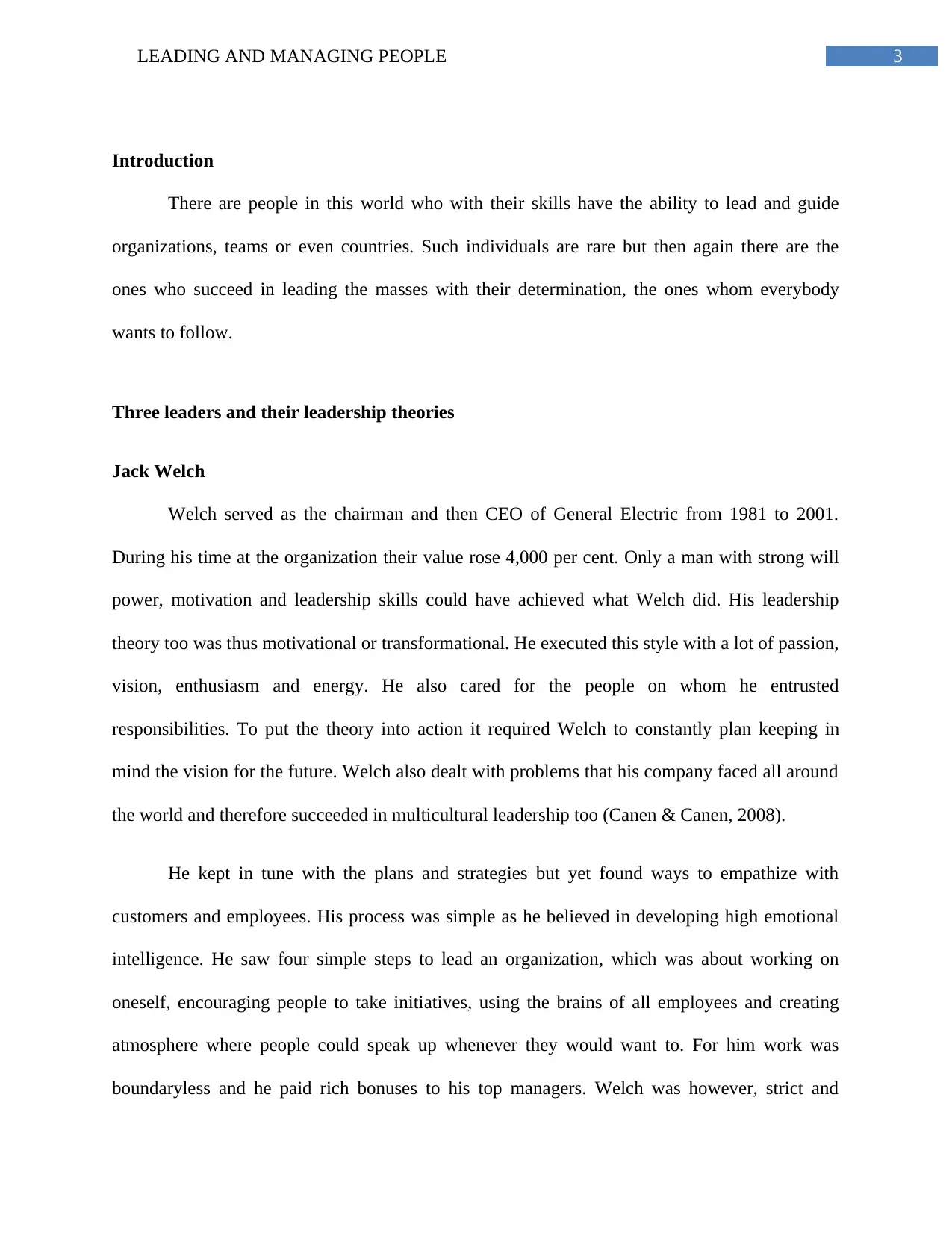
3LEADING AND MANAGING PEOPLE
Introduction
There are people in this world who with their skills have the ability to lead and guide
organizations, teams or even countries. Such individuals are rare but then again there are the
ones who succeed in leading the masses with their determination, the ones whom everybody
wants to follow.
Three leaders and their leadership theories
Jack Welch
Welch served as the chairman and then CEO of General Electric from 1981 to 2001.
During his time at the organization their value rose 4,000 per cent. Only a man with strong will
power, motivation and leadership skills could have achieved what Welch did. His leadership
theory too was thus motivational or transformational. He executed this style with a lot of passion,
vision, enthusiasm and energy. He also cared for the people on whom he entrusted
responsibilities. To put the theory into action it required Welch to constantly plan keeping in
mind the vision for the future. Welch also dealt with problems that his company faced all around
the world and therefore succeeded in multicultural leadership too (Canen & Canen, 2008).
He kept in tune with the plans and strategies but yet found ways to empathize with
customers and employees. His process was simple as he believed in developing high emotional
intelligence. He saw four simple steps to lead an organization, which was about working on
oneself, encouraging people to take initiatives, using the brains of all employees and creating
atmosphere where people could speak up whenever they would want to. For him work was
boundaryless and he paid rich bonuses to his top managers. Welch was however, strict and
Introduction
There are people in this world who with their skills have the ability to lead and guide
organizations, teams or even countries. Such individuals are rare but then again there are the
ones who succeed in leading the masses with their determination, the ones whom everybody
wants to follow.
Three leaders and their leadership theories
Jack Welch
Welch served as the chairman and then CEO of General Electric from 1981 to 2001.
During his time at the organization their value rose 4,000 per cent. Only a man with strong will
power, motivation and leadership skills could have achieved what Welch did. His leadership
theory too was thus motivational or transformational. He executed this style with a lot of passion,
vision, enthusiasm and energy. He also cared for the people on whom he entrusted
responsibilities. To put the theory into action it required Welch to constantly plan keeping in
mind the vision for the future. Welch also dealt with problems that his company faced all around
the world and therefore succeeded in multicultural leadership too (Canen & Canen, 2008).
He kept in tune with the plans and strategies but yet found ways to empathize with
customers and employees. His process was simple as he believed in developing high emotional
intelligence. He saw four simple steps to lead an organization, which was about working on
oneself, encouraging people to take initiatives, using the brains of all employees and creating
atmosphere where people could speak up whenever they would want to. For him work was
boundaryless and he paid rich bonuses to his top managers. Welch was however, strict and
Paraphrase This Document
Need a fresh take? Get an instant paraphrase of this document with our AI Paraphraser
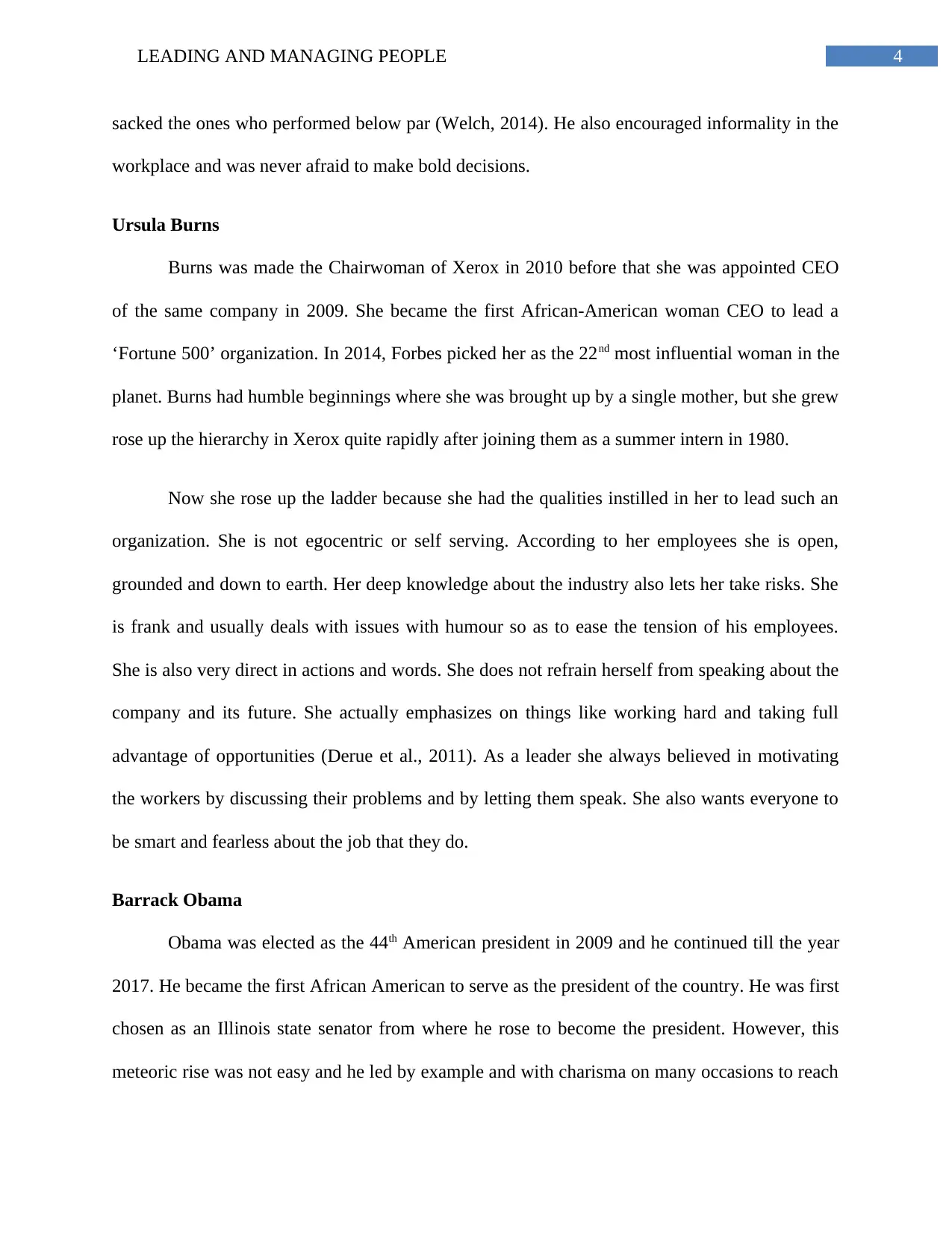
4LEADING AND MANAGING PEOPLE
sacked the ones who performed below par (Welch, 2014). He also encouraged informality in the
workplace and was never afraid to make bold decisions.
Ursula Burns
Burns was made the Chairwoman of Xerox in 2010 before that she was appointed CEO
of the same company in 2009. She became the first African-American woman CEO to lead a
‘Fortune 500’ organization. In 2014, Forbes picked her as the 22nd most influential woman in the
planet. Burns had humble beginnings where she was brought up by a single mother, but she grew
rose up the hierarchy in Xerox quite rapidly after joining them as a summer intern in 1980.
Now she rose up the ladder because she had the qualities instilled in her to lead such an
organization. She is not egocentric or self serving. According to her employees she is open,
grounded and down to earth. Her deep knowledge about the industry also lets her take risks. She
is frank and usually deals with issues with humour so as to ease the tension of his employees.
She is also very direct in actions and words. She does not refrain herself from speaking about the
company and its future. She actually emphasizes on things like working hard and taking full
advantage of opportunities (Derue et al., 2011). As a leader she always believed in motivating
the workers by discussing their problems and by letting them speak. She also wants everyone to
be smart and fearless about the job that they do.
Barrack Obama
Obama was elected as the 44th American president in 2009 and he continued till the year
2017. He became the first African American to serve as the president of the country. He was first
chosen as an Illinois state senator from where he rose to become the president. However, this
meteoric rise was not easy and he led by example and with charisma on many occasions to reach
sacked the ones who performed below par (Welch, 2014). He also encouraged informality in the
workplace and was never afraid to make bold decisions.
Ursula Burns
Burns was made the Chairwoman of Xerox in 2010 before that she was appointed CEO
of the same company in 2009. She became the first African-American woman CEO to lead a
‘Fortune 500’ organization. In 2014, Forbes picked her as the 22nd most influential woman in the
planet. Burns had humble beginnings where she was brought up by a single mother, but she grew
rose up the hierarchy in Xerox quite rapidly after joining them as a summer intern in 1980.
Now she rose up the ladder because she had the qualities instilled in her to lead such an
organization. She is not egocentric or self serving. According to her employees she is open,
grounded and down to earth. Her deep knowledge about the industry also lets her take risks. She
is frank and usually deals with issues with humour so as to ease the tension of his employees.
She is also very direct in actions and words. She does not refrain herself from speaking about the
company and its future. She actually emphasizes on things like working hard and taking full
advantage of opportunities (Derue et al., 2011). As a leader she always believed in motivating
the workers by discussing their problems and by letting them speak. She also wants everyone to
be smart and fearless about the job that they do.
Barrack Obama
Obama was elected as the 44th American president in 2009 and he continued till the year
2017. He became the first African American to serve as the president of the country. He was first
chosen as an Illinois state senator from where he rose to become the president. However, this
meteoric rise was not easy and he led by example and with charisma on many occasions to reach
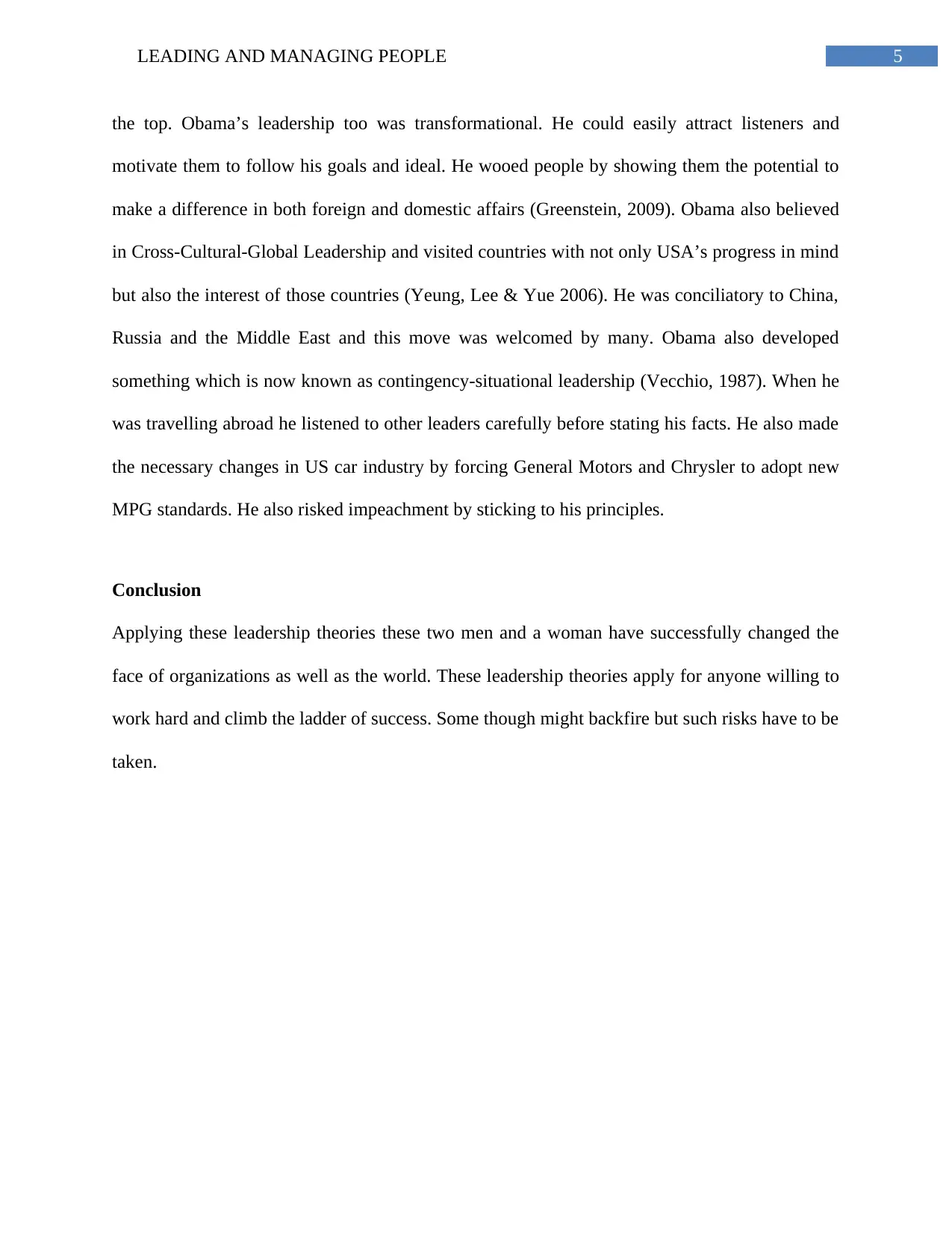
5LEADING AND MANAGING PEOPLE
the top. Obama’s leadership too was transformational. He could easily attract listeners and
motivate them to follow his goals and ideal. He wooed people by showing them the potential to
make a difference in both foreign and domestic affairs (Greenstein, 2009). Obama also believed
in Cross-Cultural-Global Leadership and visited countries with not only USA’s progress in mind
but also the interest of those countries (Yeung, Lee & Yue 2006). He was conciliatory to China,
Russia and the Middle East and this move was welcomed by many. Obama also developed
something which is now known as contingency-situational leadership (Vecchio, 1987). When he
was travelling abroad he listened to other leaders carefully before stating his facts. He also made
the necessary changes in US car industry by forcing General Motors and Chrysler to adopt new
MPG standards. He also risked impeachment by sticking to his principles.
Conclusion
Applying these leadership theories these two men and a woman have successfully changed the
face of organizations as well as the world. These leadership theories apply for anyone willing to
work hard and climb the ladder of success. Some though might backfire but such risks have to be
taken.
the top. Obama’s leadership too was transformational. He could easily attract listeners and
motivate them to follow his goals and ideal. He wooed people by showing them the potential to
make a difference in both foreign and domestic affairs (Greenstein, 2009). Obama also believed
in Cross-Cultural-Global Leadership and visited countries with not only USA’s progress in mind
but also the interest of those countries (Yeung, Lee & Yue 2006). He was conciliatory to China,
Russia and the Middle East and this move was welcomed by many. Obama also developed
something which is now known as contingency-situational leadership (Vecchio, 1987). When he
was travelling abroad he listened to other leaders carefully before stating his facts. He also made
the necessary changes in US car industry by forcing General Motors and Chrysler to adopt new
MPG standards. He also risked impeachment by sticking to his principles.
Conclusion
Applying these leadership theories these two men and a woman have successfully changed the
face of organizations as well as the world. These leadership theories apply for anyone willing to
work hard and climb the ladder of success. Some though might backfire but such risks have to be
taken.
⊘ This is a preview!⊘
Do you want full access?
Subscribe today to unlock all pages.

Trusted by 1+ million students worldwide
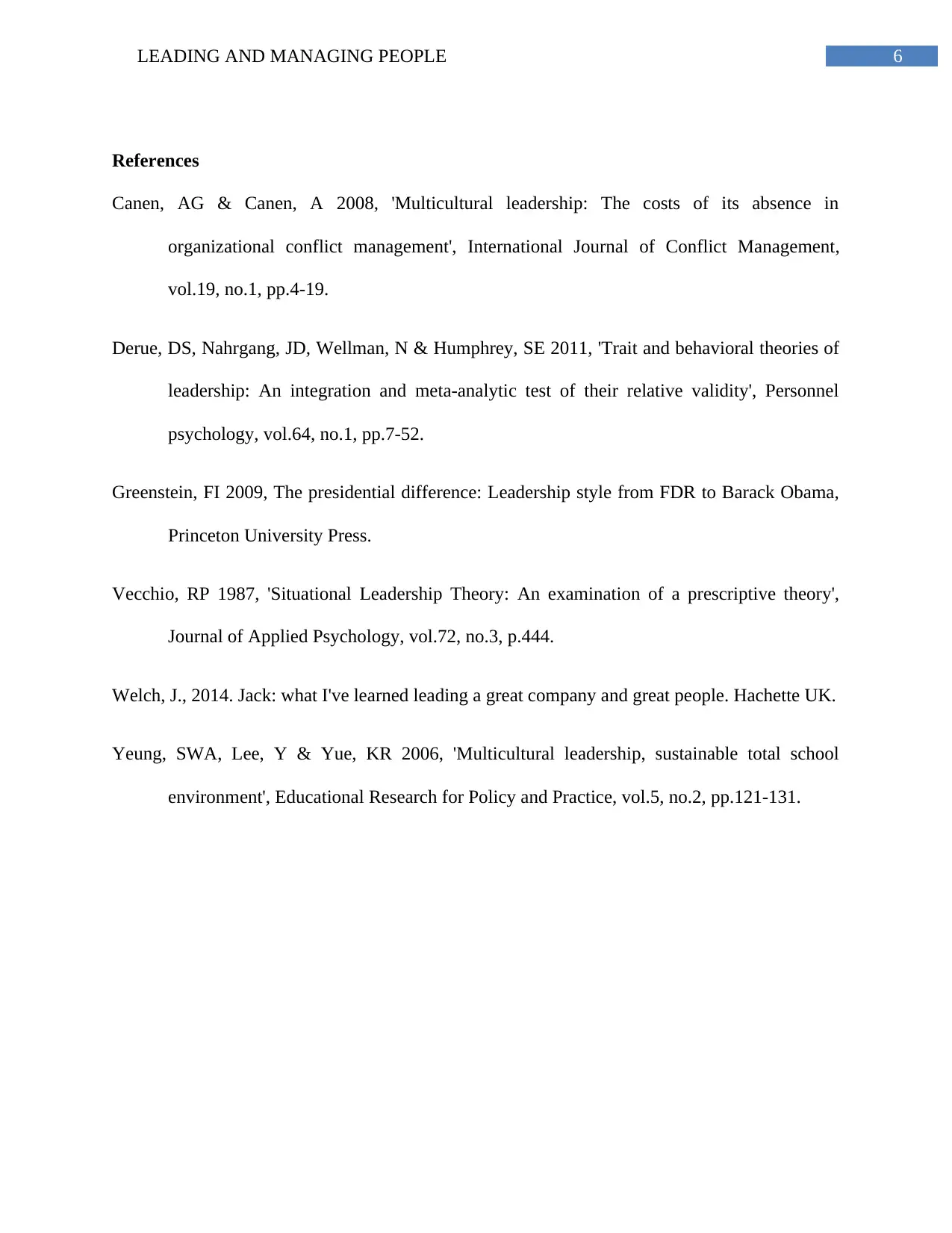
6LEADING AND MANAGING PEOPLE
References
Canen, AG & Canen, A 2008, 'Multicultural leadership: The costs of its absence in
organizational conflict management', International Journal of Conflict Management,
vol.19, no.1, pp.4-19.
Derue, DS, Nahrgang, JD, Wellman, N & Humphrey, SE 2011, 'Trait and behavioral theories of
leadership: An integration and meta‐analytic test of their relative validity', Personnel
psychology, vol.64, no.1, pp.7-52.
Greenstein, FI 2009, The presidential difference: Leadership style from FDR to Barack Obama,
Princeton University Press.
Vecchio, RP 1987, 'Situational Leadership Theory: An examination of a prescriptive theory',
Journal of Applied Psychology, vol.72, no.3, p.444.
Welch, J., 2014. Jack: what I've learned leading a great company and great people. Hachette UK.
Yeung, SWA, Lee, Y & Yue, KR 2006, 'Multicultural leadership, sustainable total school
environment', Educational Research for Policy and Practice, vol.5, no.2, pp.121-131.
References
Canen, AG & Canen, A 2008, 'Multicultural leadership: The costs of its absence in
organizational conflict management', International Journal of Conflict Management,
vol.19, no.1, pp.4-19.
Derue, DS, Nahrgang, JD, Wellman, N & Humphrey, SE 2011, 'Trait and behavioral theories of
leadership: An integration and meta‐analytic test of their relative validity', Personnel
psychology, vol.64, no.1, pp.7-52.
Greenstein, FI 2009, The presidential difference: Leadership style from FDR to Barack Obama,
Princeton University Press.
Vecchio, RP 1987, 'Situational Leadership Theory: An examination of a prescriptive theory',
Journal of Applied Psychology, vol.72, no.3, p.444.
Welch, J., 2014. Jack: what I've learned leading a great company and great people. Hachette UK.
Yeung, SWA, Lee, Y & Yue, KR 2006, 'Multicultural leadership, sustainable total school
environment', Educational Research for Policy and Practice, vol.5, no.2, pp.121-131.
1 out of 7
Related Documents
Your All-in-One AI-Powered Toolkit for Academic Success.
+13062052269
info@desklib.com
Available 24*7 on WhatsApp / Email
![[object Object]](/_next/static/media/star-bottom.7253800d.svg)
Unlock your academic potential
Copyright © 2020–2025 A2Z Services. All Rights Reserved. Developed and managed by ZUCOL.





